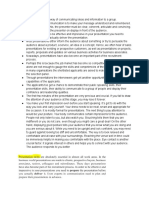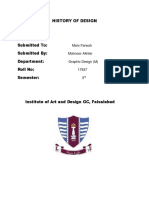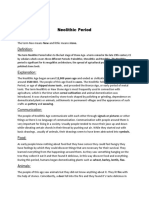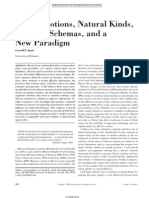Assignment English: Mahnoor Akhter
Assignment English: Mahnoor Akhter
Uploaded by
Mahnoor AkhterCopyright:
Available Formats
Assignment English: Mahnoor Akhter
Assignment English: Mahnoor Akhter
Uploaded by
Mahnoor AkhterOriginal Title
Copyright
Available Formats
Share this document
Did you find this document useful?
Is this content inappropriate?
Copyright:
Available Formats
Assignment English: Mahnoor Akhter
Assignment English: Mahnoor Akhter
Uploaded by
Mahnoor AkhterCopyright:
Available Formats
ASSIGNMENT
ENGLISH
NAME: Mahnoor Akhter
ROLL NO: 17937
DEPARTMENT: Graphic Design
SEMESTER: 1st
SUBMITTED TO: Mam Mehwish
Government College University, Faisalabad.
Skill
Definition:
A skill is the ability to carry out a task with determined results often within a given amount of
time, energy, or both. Skills can often be divided into domain-general and domain-specific
skills. For example, in the domain of work, some general skills would include time management,
teamwork and leadership, self-motivation and others, whereas domain-specific skills would be
used only for a certain job. Skill usually requires certain environmental stimuli and situations to
assess the level of skill being shown and used.
Presentataion
Definition:
A speech or talk in which a new product, idea, or piece of work is shown and explained to an
audience A presentation program is often used to generate the presentation content, some of
which also allow presentations to be developed collaboratively, e.g. using the Internet by
geographically disparate collaborators.
Presentataion Skills
Presenting information clearly and effectively is a key skill to get your message or opinion
across and, today, presentation skills are required in almost every field. Whether you are a
student, administrator or executive, if you wish to start up your own business, apply for a grant
or stand for an elected position, you may very well be asked to make a presentation. This can
be a very daunting prospect.
Preparing a Presentation:
Preparation is the most important part of making a successful presentation. This is the crucial
foundation and there should be no short-cuts. Write out your main argument or conclusion,
just as you would for a writing activity.
• Write out the main points as headings and bullet points on a series of index cards or on
a sheet of paper. These will prompt your memory if you lose your place.
• Visit the room and try out the technology. This will increase your confidence on the day.
• Time yourself making the presentation. Cut it back if it is too long.
• Have a clear and opening and closing line that refers directly to the main issue.
Organizing the Presentation Material:
Irrespective of whether the occasion is formal or informal, you should always aim to give a
clear, well-structured delivery.
You should know exactly what you want to say and the order in which you want to say
it. Clarity of ideas and good organization should result in a lively, logical and compelling
message.
Deciding the Presentation Method:
Once you have decided on your key messages, and thought about organizing your material, you
next need to think about how you will present. Presentations range from the formal to the
informal, and your choice of presentation method will depend on many factors, including the
audience, the venue, the facilities, and your own preferences.
Managing your Presentation Notes:
Few people are able to give a presentation without notes. You will need to know your own
abilities and decide how best to make the presentation. You might manage your talk by using
full text, notes on cue cards, keywords on cue cards, or mind maps.
Use visual aids:
• Use acetates on an overhead projector. Use only a few lines of text in large print or a
simple diagram for each acetate.
• If you are very confident the technology will work, you may prefer to use PowerPoint.
However, ensure you have acetate back-ups.
• If you use PowerPoint or similar software, avoid gimmicks such as jingles, animation, or
sound effects that either distract attention or slow down the presentation. If you ‘fly
in’ text, make sure you use the same method throughout the presentation.
• Keep it simple. Use technology as a tool where it helps, rather than for the sake of it.
Practice:
Naturally, you'll want to rehearse your presentation multiple times. While it can be difficult for
those with packed schedules to spare time to practice, it's essential if you want to deliver a
rousing presentation. If you really want to sound great, write out your speech rather than
taking chances winging it – if you get nervous about speaking, a script is your best friend.
Try to practice where you'll be delivering your talk. Some acting strategists suggest rehearsing
lines in various positions – standing up, sitting down, with arms open wide, on one leg. The
more you mix up your position and setting, the more comfortable you'll feel with your speech,
try recording your presentation and playing it back to evaluate which areas need work.
Listening to recordings of your past talks can clue you in to bad habits.
Remember the audience:
The most important aspect of making a presentation is to consider the needs of the audience. If
you simply read or repeat information ‘off by heart’ your presentation will probably sound very
flat and dull to the audience. There is also a greater risk that you will lose your place in your
talk.
If you are a natural entertainer, then use these skills in your presentation. However, bear in
mind the purpose of the presentation and how it will be assessed. Make sure you cover the
essential information and that this comes across very clearly to the audience.
On the day:
• Arrive first.
• Arrive early enough to check the equipment and seating are as you want them.
• Have water to hand.
• Act confident no matter how you are feeling.
• Do not make apologies for things you haven’t done. Act as if it all as if everything is as it
should be.
• Make eye contact with the audience.
• Smile.
Speed pacing:
Many presentations, even those by professionals, may go wrong because people try to cover
too much information in the time available. They then try and gabble their way through a set of
bullet points at top speed even though people cannot take in what is being said.
Cut out unnecessary information - and even information you think is valuable if it does not fit
into the time allowed. You must be able to deliver the whole presentation at a speed slower
than your normal talking speech. This is necessary so that people can take in what you are
saying and jot down some notes.
Leave time for questions:
Even if the time available to you is brief, leave a few minutes for people to ask questions. This
will indicate that you are confident about your material.
Prepare an ‘additional point’ to use up the time in case there are no questions.
Actively Engage the Audience:
People love to talk and make their opinions heard, but the nature of presentations can often
seem like a one-sided proposition. Asking the audience what they think, inviting questions, and
other means of welcoming audience participation can boost engagement and make attendees
feel like a part of a conversation. It also makes you, the presenter, seem much more relatable.
Work on Your Pauses:
When you're nervous, it's easy to speed up your presentation and end up talking too fast, which
in turn causes you to run out of breath, get more nervous, and panic.
Don't be afraid to slow down and use pauses in your speech. Pausing can be used to emphasize
certain points and to help your talk feel more conversational. If you feel yourself losing control
of your pacing, just take a nice pause and keep cool.
Use a Power Stance:
Practicing confident body language is another way to boost your pre-presentation jitters. When
your body is physically demonstrating confidence, your mind will follow suit. Studies have
shown that using power stances a few minutes before giving a talk (or heading to a big
interview) creates a lasting sense of confidence and assurance. Standing or walking a bit will
help you harness those stomach bats. Before you go on stage, strike your best Power Ranger
stance and hold your head high.
Important things to remember when you are giving a presentation:
• Introduce yourself by name.
• Bring back up visual aids in case your PowerPoint presentation fails.
• Slow down when you are speaking.
• Make eye contact with the audience.
• Smile.
• Ask for questions from the audience at the conclusion of the presentation.
You might also like
- Applied Psychology Putting Theory Into Practice 2nd EditionDocument372 pagesApplied Psychology Putting Theory Into Practice 2nd Editionsimran singh100% (7)
- Edtpa Regroup A Ten As Ones 4Document15 pagesEdtpa Regroup A Ten As Ones 4api-422625647No ratings yet
- SOP Edu LeadershipDocument1 pageSOP Edu LeadershipHiresha PatelNo ratings yet
- Eapp Position PaperDocument2 pagesEapp Position PaperVictorio Amazona50% (4)
- Form 4 Science Spinal Cord & Reflex Act WorksheetDocument2 pagesForm 4 Science Spinal Cord & Reflex Act Worksheetnbha0% (1)
- Stat 2112 ProjectDocument7 pagesStat 2112 Projectweberas13No ratings yet
- EnglishDocument13 pagesEnglishbparinitha3No ratings yet
- Developing Presentation SkillsDocument4 pagesDeveloping Presentation SkillszionNo ratings yet
- PresentationsDocument13 pagesPresentationsMalvin NdumeNo ratings yet
- Oral Presentation Skills (Notes)Document24 pagesOral Presentation Skills (Notes)Hammas khanNo ratings yet
- Guidelines For Oral PresentationDocument5 pagesGuidelines For Oral PresentationseoNo ratings yet
- Powerpoint PresentationDocument10 pagesPowerpoint PresentationJamil100% (1)
- 10 Key Strategies For Enhancing Your Presentation SkillsDocument3 pages10 Key Strategies For Enhancing Your Presentation Skillsprincehand14No ratings yet
- C4 Visual and Oral PresentationsDocument24 pagesC4 Visual and Oral PresentationsRomina DaquelNo ratings yet
- UFC Study Skills Lesson 2 S2Document4 pagesUFC Study Skills Lesson 2 S2arbaoui4421No ratings yet
- Presentations SkillsDocument5 pagesPresentations Skillsjaveriakhaliq89No ratings yet
- Interview Presentations: Steps For Interview Presentation SuccessDocument3 pagesInterview Presentations: Steps For Interview Presentation SuccessAditya SharmaNo ratings yet
- Unit: 4 Effective Presentation SkillDocument6 pagesUnit: 4 Effective Presentation SkillSamarth DesaiNo ratings yet
- Hassnain IjazDocument12 pagesHassnain IjazHassnain IjazNo ratings yet
- Module 3 Public Speaking Conducting Training ProgramsDocument14 pagesModule 3 Public Speaking Conducting Training ProgramsHeidi100% (2)
- BC Notes Unit 4 and 5Document94 pagesBC Notes Unit 4 and 5Rahul KumarNo ratings yet
- LECTURE 05 Presentation SkillsDocument64 pagesLECTURE 05 Presentation Skillswaheed shahzadNo ratings yet
- Degree Engineeringalpesh4-Effective Presentation StrategiesDocument14 pagesDegree Engineeringalpesh4-Effective Presentation StrategiesZubair MushtaqNo ratings yet
- Presentation Skills - 4P's: Plan, Prepare, Practice and PerformDocument3 pagesPresentation Skills - 4P's: Plan, Prepare, Practice and Performmh2666894No ratings yet
- Guidelines For Oral PresentationsDocument4 pagesGuidelines For Oral Presentationsapi-268558649No ratings yet
- The Oral Presentation-1-1Document6 pagesThe Oral Presentation-1-1Bianca Erika TorresNo ratings yet
- Successful Presentations at GMCDocument4 pagesSuccessful Presentations at GMCClemente Rafael Marval EscalonaNo ratings yet
- Unit 1 - Introduction To Presentation Skills PDFDocument23 pagesUnit 1 - Introduction To Presentation Skills PDFBisham HurreeramNo ratings yet
- How To Give A Good PresentationDocument7 pagesHow To Give A Good Presentationasdfpqw8ehfqpweruiofNo ratings yet
- Business Communication AssignmentDocument19 pagesBusiness Communication AssignmentAditya SinghalNo ratings yet
- Presentation Module - 4Document24 pagesPresentation Module - 4Ashok Kumar SinhaNo ratings yet
- Effective Persentation XkillsDocument26 pagesEffective Persentation XkillsMazhar UllahNo ratings yet
- Academic Presentations: How To Manage A Group PresentationDocument9 pagesAcademic Presentations: How To Manage A Group PresentationJungNo ratings yet
- Class Notes Module 5.2 PresentationDocument33 pagesClass Notes Module 5.2 PresentationSoumya Ranjan KabasiNo ratings yet
- Practical 4 Presentaion SkillsDocument4 pagesPractical 4 Presentaion SkillsGauravNo ratings yet
- Presentation Skills-Planning, Structure and Delivery: Types of Presentations Informative PresentationsDocument8 pagesPresentation Skills-Planning, Structure and Delivery: Types of Presentations Informative PresentationsGray FullbladyerNo ratings yet
- Presentation Techniques - NewDocument27 pagesPresentation Techniques - New2003 rockyNo ratings yet
- Presentations Guide FinalDocument6 pagesPresentations Guide FinalZsuzsanna TuruczNo ratings yet
- 10 Tips For Giving A Great Presentation - Course Completion - Pranati WaghodekarDocument4 pages10 Tips For Giving A Great Presentation - Course Completion - Pranati WaghodekarOmkar AutadeNo ratings yet
- Making Presentations: ://pat - Ipti.edu - My/login/index - PHP&H Bda14Document8 pagesMaking Presentations: ://pat - Ipti.edu - My/login/index - PHP&H Bda14janeNo ratings yet
- How To Make A Good PresentationDocument34 pagesHow To Make A Good PresentationahmedjamyNo ratings yet
- M Skills NotesDocument13 pagesM Skills Notesjoseph.kabaso96No ratings yet
- Presenting Conference PresentationDocument5 pagesPresenting Conference PresentationAGBA NJI THOMASNo ratings yet
- Tips For Presenters: Compiled by Professional DevelopmentDocument23 pagesTips For Presenters: Compiled by Professional Developmentkhushal100% (1)
- Effective Presentation SkillsDocument10 pagesEffective Presentation Skillseduosma13No ratings yet
- PreparationDocument7 pagesPreparationPes LoverNo ratings yet
- PresentationDocument12 pagesPresentationSubham .MNo ratings yet
- Q. What Is Presentation?Document9 pagesQ. What Is Presentation?Anil Bhard WajNo ratings yet
- Life Skills Dev 2ND Chap NotesDocument13 pagesLife Skills Dev 2ND Chap NotesHOONARNo ratings yet
- BSW Oral PresentationDocument9 pagesBSW Oral PresentationhyacintumNo ratings yet
- Presentation SkillsDocument18 pagesPresentation Skillsjagadeesh yadaNo ratings yet
- Designing and Delivering Business PresentationsDocument17 pagesDesigning and Delivering Business PresentationsJitesh A PatelNo ratings yet
- HUM102 Handouts Lecture21 PDFDocument10 pagesHUM102 Handouts Lecture21 PDFWahaj ShahNo ratings yet
- 3 Oral PresentationsDocument22 pages3 Oral PresentationsYN John100% (1)
- Topic 5 Presentation SkillsDocument5 pagesTopic 5 Presentation Skillssetawo8674No ratings yet
- Presentation Study MaterialDocument7 pagesPresentation Study Materialshaistabanu1408No ratings yet
- The Oral Presentation PPT PCDocument39 pagesThe Oral Presentation PPT PCWinsie GarciaNo ratings yet
- Steps in Preparing A PresentationDocument3 pagesSteps in Preparing A PresentationКамилла МолдалиеваNo ratings yet
- Formal PresentationDocument5 pagesFormal PresentationMuhammad Ali Khalid100% (1)
- CPS Presentation SkillsDocument39 pagesCPS Presentation SkillsTalha JabbarNo ratings yet
- SCIE Slides: Presentation Notes: Workforce DevelopmentDocument12 pagesSCIE Slides: Presentation Notes: Workforce DevelopmentPASCHAL WADOSANo ratings yet
- Presentation SkillsDocument7 pagesPresentation SkillsAbdul Hanan KhanNo ratings yet
- Module 4Document12 pagesModule 4Ravi.GNo ratings yet
- What Actually Is A SeminarDocument5 pagesWhat Actually Is A SeminaradeelsiddiquepsoNo ratings yet
- Give Great Presentations: How to speak confidently and make your pointFrom EverandGive Great Presentations: How to speak confidently and make your pointNo ratings yet
- Geography of PakistanDocument6 pagesGeography of PakistanMahnoor AkhterNo ratings yet
- Tools PDFDocument8 pagesTools PDFMahnoor AkhterNo ratings yet
- Formation of All India Muslim LeagueDocument3 pagesFormation of All India Muslim LeagueMahnoor AkhterNo ratings yet
- Constitutional Development of PakistanDocument9 pagesConstitutional Development of PakistanMahnoor AkhterNo ratings yet
- History of Design: Mam Farwah Mahnoor Akhter Graphic Design (M) 17937 3Document5 pagesHistory of Design: Mam Farwah Mahnoor Akhter Graphic Design (M) 17937 3Mahnoor AkhterNo ratings yet
- Resultcard PDFDocument1 pageResultcard PDFMahnoor AkhterNo ratings yet
- Cripps 3Document9 pagesCripps 3Mahnoor AkhterNo ratings yet
- Cro Magno PDFDocument4 pagesCro Magno PDFMahnoor AkhterNo ratings yet
- History of Design: Mam Farwah Mahnoor Akhter Graphic Design (M) 17937 3Document2 pagesHistory of Design: Mam Farwah Mahnoor Akhter Graphic Design (M) 17937 3Mahnoor AkhterNo ratings yet
- Romans PDFDocument6 pagesRomans PDFMahnoor Akhter100% (1)
- Presentation On Fonts: Presented To Mam FarwahDocument12 pagesPresentation On Fonts: Presented To Mam FarwahMahnoor AkhterNo ratings yet
- Eid Milad Un NabiDocument1 pageEid Milad Un NabiMahnoor AkhterNo ratings yet
- Cro Magnons: FeaturesDocument2 pagesCro Magnons: FeaturesMahnoor AkhterNo ratings yet
- Cro M PDFDocument2 pagesCro M PDFMahnoor AkhterNo ratings yet
- Classification of Illuminated ManuscriptDocument11 pagesClassification of Illuminated ManuscriptMahnoor AkhterNo ratings yet
- Classification of Illuminated Manuscript Insular: HistoryDocument4 pagesClassification of Illuminated Manuscript Insular: HistoryMahnoor AkhterNo ratings yet
- GRAPDocument1 pageGRAPMahnoor AkhterNo ratings yet
- Mam Aneeza Mahnoor Akhter Graphic Design (M) 17937 3Document2 pagesMam Aneeza Mahnoor Akhter Graphic Design (M) 17937 3Mahnoor AkhterNo ratings yet
- History of DesignDocument6 pagesHistory of DesignMahnoor AkhterNo ratings yet
- Result of Entrance Test 2018, Held On 23 September 2018: Mahnoor AkhterDocument1 pageResult of Entrance Test 2018, Held On 23 September 2018: Mahnoor AkhterMahnoor AkhterNo ratings yet
- Assignment Arts Appreciation Submitted To:: Mam SanaDocument9 pagesAssignment Arts Appreciation Submitted To:: Mam SanaMahnoor AkhterNo ratings yet
- Neolithicc 1Document4 pagesNeolithicc 1Mahnoor AkhterNo ratings yet
- Venus From Dolni Vestonice: DiscoveryDocument5 pagesVenus From Dolni Vestonice: DiscoveryMahnoor AkhterNo ratings yet
- Direct SpeechDocument9 pagesDirect SpeechMahnoor AkhterNo ratings yet
- Data Collection and SamplingDocument16 pagesData Collection and SamplingDe Guia Novee MaeNo ratings yet
- Service Quality HRM AssignmentDocument13 pagesService Quality HRM AssignmentJM TroNo ratings yet
- Bronfenbrenner's Ecological Theory and Its Relevance For Pastoral MinistryDocument18 pagesBronfenbrenner's Ecological Theory and Its Relevance For Pastoral MinistryAtoNo ratings yet
- Exercise On Self-Leadership - Aditya VidolkarDocument10 pagesExercise On Self-Leadership - Aditya VidolkarAditya VidolkarNo ratings yet
- Vocational Guidance Sheng's ReportDocument34 pagesVocational Guidance Sheng's ReportYune Doromas100% (2)
- British Women TranslatorsDocument14 pagesBritish Women Translatorscatrinel_049330No ratings yet
- The Need For Measurement Beyond GDP: - Measuring - Quality - of - Life#framework - For - Measuring - Quality - of - LifeDocument5 pagesThe Need For Measurement Beyond GDP: - Measuring - Quality - of - Life#framework - For - Measuring - Quality - of - LifeAdina OjicaNo ratings yet
- FIL 118 Pagtuturo at Pagtataya Sa Panitikan SyllabusDocument8 pagesFIL 118 Pagtuturo at Pagtataya Sa Panitikan SyllabusJovito Limot100% (3)
- Izard, 2007 Basic Emotions, Natural Kinds, Emotion Schemas, and A New ParadigmDocument21 pagesIzard, 2007 Basic Emotions, Natural Kinds, Emotion Schemas, and A New ParadigmaldogiovanniNo ratings yet
- Adaptive Leadership For ResultsDocument2 pagesAdaptive Leadership For ResultsVoices Against-Corruption100% (1)
- Dahrendorf, "Out of Utopia - PDFDocument14 pagesDahrendorf, "Out of Utopia - PDFCarlos ReyesNo ratings yet
- Seminarski Rad: Internacionalni Univerzitet Brčko Distrikt (Saobraćajno Inženjerstvo)Document24 pagesSeminarski Rad: Internacionalni Univerzitet Brčko Distrikt (Saobraćajno Inženjerstvo)Fahrudin ImširovićNo ratings yet
- Hypothesis Testing Research MethodologyDocument13 pagesHypothesis Testing Research Methodologyrohan_jangid8No ratings yet
- Four Phases of Strategic ManagementDocument12 pagesFour Phases of Strategic ManagementSaurabh Kumar GautamNo ratings yet
- Intro To CommunicationDocument5 pagesIntro To CommunicationAcad CARTCNo ratings yet
- OBDocument6 pagesOBnidhipandeNo ratings yet
- Protection Motivation TheoryDocument21 pagesProtection Motivation TheoryUsamaNo ratings yet
- PuctumDocument126 pagesPuctumgizlealvesNo ratings yet
- Reading Texts CricallyDocument18 pagesReading Texts CricallyJoshua Estioca CenizaNo ratings yet
- Beauty and The Beast and Social DynamicsDocument9 pagesBeauty and The Beast and Social DynamicsEric ChienNo ratings yet
- ေန၀င္းျမင့္ ေအးေအးလူလူ အေတြးမ်ားDocument304 pagesေန၀င္းျမင့္ ေအးေအးလူလူ အေတြးမ်ားmaykhabookshelfNo ratings yet
- William Verrone - Transgression and Transcendence in The Films of Werner HerzogDocument25 pagesWilliam Verrone - Transgression and Transcendence in The Films of Werner HerzogSoso ChauchidzeNo ratings yet
- Top 10 Ways To Combat StressDocument5 pagesTop 10 Ways To Combat StressZainorin AliNo ratings yet
- Chapter 3Document3 pagesChapter 3greate magaoayNo ratings yet

















































































































